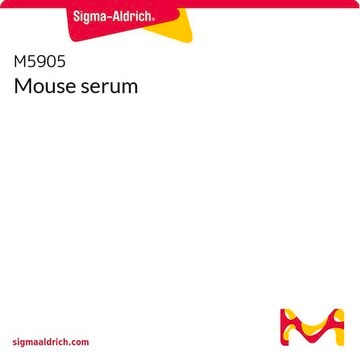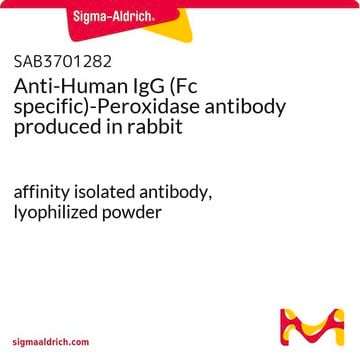SAB4200862
Anti-Salmonella enterica typhimurium antibody produced in rabbit
IgG fraction of antiserum
Synonyme(s) :
Salmonella typhimurium (Loeffler) Castellani and Chalmers
About This Item
Produits recommandés
Source biologique
rabbit
Niveau de qualité
Forme d'anticorps
IgG fraction of antiserum
Type de produit anticorps
primary antibodies
Forme
liquid
Espèces réactives
(Salmonella enterica typhimurium)
Conditionnement
pkg of 100 μL
pkg of 25 μL
Concentration
~1 mg/mL
Technique(s)
immunoblotting: 1:2000-1:4000 using Salmonella enterica typhimurium LPS
indirect ELISA: 1:2000-1:4000 using using whole Salmonella
Conditions d'expédition
dry ice
Température de stockage
−20°C
Modification post-traductionnelle de la cible
unmodified
Description générale
Spécificité
Application
Actions biochimiques/physiologiques
higher than the extracellular pH.6 Then, S. typhimurium penetrates the mucus barrier of the intestinal wall and adheres to the epithelium to initiate the infection, that may results in diarrhea, loss of electrolytes and local inflammation of the intestine.7-9
After S. typhimurium is being engulfed by enterocytes, it forms intracellular phagosomal compartments, termed Salmonella-Containing Vacuoles (SCV) where the bacterium is able to survive and multiply.2,9 S. typhimurium has various virulence factors, most of them are enoced by genes located in the Salmonella Pathogenicity Islands (SPI).10 S. typhimurium uses flagella for motility after ingestion11 and then type I fimbrae12 and adhesins to adhere to the epithelium. It expresses Type III Secretion System (T3SS) that enables the bacteria to inject into the host cells a variety of effector proteins such as, SipABCD, SptP, SpiC and SopB that alter cellular functions to promote bacterial invasion, survival and propagation.2,13,14 Moreover, S. typhimurium is able to form resistant biofilms15 that contribute to the establishment of chronic, ""carrier state"" infections. In addition, human specific S. typhiis used as a model for the animal study of typhoid fever.16
Forme physique
Stockage et stabilité
Clause de non-responsabilité
Not finding the right product?
Try our Outil de sélection de produits.
Code de la classe de stockage
12 - Non Combustible Liquids
Classe de danger pour l'eau (WGK)
WGK 1
Certificats d'analyse (COA)
Recherchez un Certificats d'analyse (COA) en saisissant le numéro de lot du produit. Les numéros de lot figurent sur l'étiquette du produit après les mots "Lot" ou "Batch".
Déjà en possession de ce produit ?
Retrouvez la documentation relative aux produits que vous avez récemment achetés dans la Bibliothèque de documents.
Notre équipe de scientifiques dispose d'une expérience dans tous les secteurs de la recherche, notamment en sciences de la vie, science des matériaux, synthèse chimique, chromatographie, analyse et dans de nombreux autres domaines..
Contacter notre Service technique








